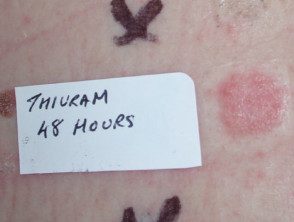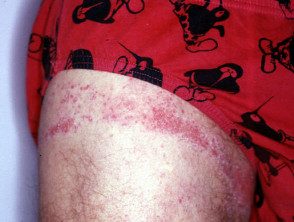Allergy to rubber
Allergic reactions Rubber may be due to an allergy to natural latex sap or to one of the many chemicals used in the manufacture of rubber. The types of chemicals used in the manufacture of rubber include:
|
|
Allergy can probably occur to any of these chemicals, although rubber accelerators seem to cause the biggest problems.
Contact allergy to rubber accelerators

Positive patch test for thiuram

Rubber dermatitis

Patch tests

Rubber dermatitis
What are rubber accelerators?
Rubber accelerators are chemicals used to speed up the rubber manufacturing process (vulcanization). This process makes untreated natural rubber latex suitable for use in the manufacture of many rubber products. There are many types of rubber accelerators in use, but the ones listed below cause the most cases of rubber contact. dermatitis:
| Chemical | Formula | CAS number |
|
C7 7H5 5NS2 C13Hsixteennorth2S2 C14H8north2S4 4 C11H12north2S20 |
149-30-4 95-33-0 120-78-5 102-77-2 |
|
C10H20north2S4 4Zn |
14324-55-1 |
|
C6 6H12north2S3 CsixteenH12north2S4 4 C10H20north2S4 4 (C5 5H10NCS3)2 |
97,74,5 137-26-8 97-77-8 120-54-7 |
|
(CH2)6 6north4 4 | 100-97-0 |
What products contain rubber accelerators?
Almost all rubber compounds contain rubber accelerators. The following list shows the extended Use of rubber products with which we can come into contact on a daily basis:
Household / Recreational Rubber Products
- non-slip mat backing
- balloons
- elastic bands
- garden hoses and gloves
- kitchen gloves
- pillows and mattresses
- rubber gloves
- sports equipment with rubber handle, eg. racquet handles for golf clubs and tennis rackets
- rubber handles (for example, bicycles, car steering wheel)
- rubber kitchen utensils
- rubber swimming caps and goggles
Clothes and shoes
- elastic in underwear and swimwear
- Wellingtons
- Sneakers
- sneakers
- rubber shoe insoles
- elastic waistbands
- bra cups
Cosmetics and health products.
- rubber makeup sponges
- diaphragms
- rubber latex condoms
- thiuram is in the oral medicine Antabuse (used to treat alcoholism)
Job sources
- commercial and agricultural fungicides and pesticides
- conveyor belts
- dental dams
- headphones
- elastic bandages
- electric laces
- exam and surgical gloves
- Gas mask
- fuel tank liner
- rubber protective aprons
- rubber hoses, seals and cables
- rubber mats
- rubber stoppers in medical syringes
- rubber tires and tubes
- goggles
- shock absorbers
- springs
- stethoscopes
- veterinary products, eg flea and tick sprays / powders
It is often difficult to know which rubber product contains which rubber accelerators. Often times, the manufacturer of the product will not know either.
What are the reactions to rubber accelerators?
the eruption it is known as allergic contact dermatitis. It can occur in many areas and in any of several patterns. The following table describes some of the common areas where a rubber accelerator allergy can occur, the usual cause, and any distinguishing features of the allergy.
| Location | Why | Characteristics |
| Hands |
|
|
| Expensive |
|
|
| Feet / shoe dermatitis |
|
|
| Genitals |
|
|
| Other parts of the body |
|
|
How did I get allergic to rubber accelerators?
Chronic Exposure is a likely reason. Surgeons, nurses, dentists, hairdressers, and others who use rubber gloves for work purposes can often develop sensitivity to natural rubber latex and rubber accelerators. In these cases, the rubber allergy can come as a consequence of trying to protect your hands from others. Allergens.
Am I allergic to rubber accelerators?
The allergy to rubber accelerators is diagnosed by medical history and by special allergy tests, patch tests These tests can identify which specific rubber accelerators you are allergic to.
The thiuram mixture tests four thiuram chemicals with one test. One of these four will cause about 9 out of 10 cases of allergy to thiuram mixture. Similarly, the mercapto mixture tests for 3 chemicals in one test.
You can do a self allergy test on a rubber product, but this should only be done after talking to your dermatologist. Do this only with items designed to stay on the skin, such as underwear or shoes. Initially, allow the item to be in contact with the skin of your forearm for a short period of time, say 1 hour. For the next 4 days, look for any reaction. If no reaction occurs, slowly extend the period of contact with your skin to a maximum of 48 hours.
Do not test insecticides or other chemicals in this way.
What should I do to avoid a rubber accelerator allergy?
The best way to avoid a rubber accelerator allergy is to learn about products that contain rubber accelerators. However, it is generally difficult to determine which products contain rubber accelerators and which do not.
Minimize your exposure to all rubber products. Use alternative products made from vinyl, plastic, wood, leather, or fabric. Although some rubber gloves are labeled 'hypoallergenic', it is wise to contact the manufacturer to determine if they contain any of the rubber accelerators to which you are allergic. Vinyl gloves may be a suitable alternative, although some people are allergic to rubber and vinyl. Tactylon® gloves are a good alternative for most people. Be aware that some rubber gloves provide less protection against viruses and certain chemicals than rubber gloves. Discuss your glove requirements with your supplier / manufacturer.
If you are sensitive to rubber accelerators and are undergoing dental work or surgery, you should inform your dentist or doctor so that they can use alternative gloves that do not have rubber accelerators or perform a patch test in advance with the gloves that plan to use.
Avoid shoes made with rubber accelerators. Try on the shoes by wearing them for a few days and watch for a skin rash (shoe dermatitis) or do a patch test on the shoes. Any socks or socks that have been worn with shoes that cause allergies can become contaminated with rubber. They should not be reused, as even washing may not remove the contaminant.
Rubber-free condoms (for example, Durex Avanti) and plastic diaphragms may be suitable contraceptive alternatives. Cover the padded arms of upholstered furniture with a towel and avoid walking barefoot on rubber-coated rugs.
Treatment of allergy to rubber accelerator
Treatment of the rash caused by rubber accelerators is with medications that are used to treat acute dermatitis / eczema
Shoe dermatitis must be properly diagnosed and treated. Contact dermatitis of the feet can often be infected with Staphylococcus aureus (it can also be confused with the fungus infection, tinea pedis). Acute dermatitis can be treated with wet bandages of Burrow's solution or dilute vinegar. Short courses of systemic Corticosteroids can speed healing. Chronic shoe dermatitis may need to be treated with long-term treatment of current corticosteroids and / or coal tar and emollients. It is essential that you wear shoes that are free from the causative allergens.
